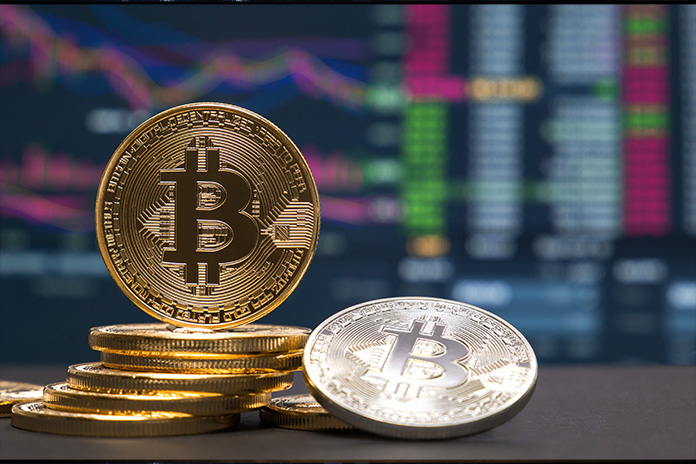
BITCOIN is hovering around all-time highs (ATH), but has yet to stir significant interest from the crowd.
Having surpassed its 2021 all-time-high price of just over US$69,000 in March of 2024 to reach over $73,000 bitcoin (BTC) seems poised to surge higher.
Notably absent is retail interest, with the majority of price action thought to be due to institutional adoption brought about by the recent approval of spot ETFs.
Significance Of Spot ETFs
In reference to government pushback on crypto assets, community commentators commonly cite a 1918 quote by activist Nicholas Klein: “First they ignore you, then they laugh at you, then they fight you, then you win.” Admittedly, ETFs have offered regulators a way to put a leash on the largest crypto asset, bringing it into their own domain and pumping it full of capital with the hopes of taming its volatile behaviour and discouraging misuse.
Exchange-traded funds (ETFs) track the price of a specific commodity (e.g. Gold) or index (e.g. S&P 500, a collection of stocks). Run by financial entities, they can provide convenient access to various assets through brokerages.
Initially equating cryptocurrencies to unregistered securities, US securities regulator, the Securities Exchange Commission (SEC), finally approved the trading of spot bitcoin ETFs.
By approving ETFs, the SEC has indirectly admitted that it categorises bitcoin as a commodity, hence regulation of its public sales does not fall under their jurisdiction.
Spot ETF providers typically purchase and take custody of the asset in question, and issue shares against them.

Spot ETFs could unleash the vast and untapped pool of institutional capital from banks, pension funds, businesses and hedge funds onto the bitcoin market. Other benefits include outsourcing the often tricky issue of safely taking custody of the digital asset to larger, more tech savvy institutions (roughly 20% of bitcoin has been permanently lost), and avoiding the use of centralised crypto exchanges, such as FTX, which have been plagued with issues in recent years.
However, there is some irony in a cypherpunk (individuals advocating widespread use of strong cryptography and privacy-enhancing technologies for social and political change) community being eager for traditional finance institutions to buy their coins. Diehard fanatics would say this goes against the purpose of cryptocurrencies, which is to keep custody of their assets and enable peer-to-peer or cross-border payments without the need for third-party institutions.
ALSO READ: How safe is your VPN service?
ETF — A Snap History
Regulators have long since approved several futures ETFs that provide exposure to the price of bitcoin, but whose issuers do not take custody of the physical assets themselves, hence not generating any real demand. The first of these was the ProShares bitcoin Strategy ETF, which launched in October 2021.
The first global spot bitcoin ETF was launched in 2023 by Canadian asset manager Purpose Investments. To date it has accumulated over 27,000 BTC for willing investors, amounting to US$1.93 billion dollars at the current, early June 2024 BTC price.
In January 2024, 11 spot bitcoin ETFs were approved, issued by asset management giants including Blackrock, Fidelity and ARK, thus far having facilitated over $15 billion in net inflows. On 15 April, Hong Kong Securities and Futures Commission (SFC) greenlit both spot bitcoin and ethereum ETFs, shortly after three offshore Chinese asset managers, China AMC, Harvest, and Bosera and Hashkey began offering ETF products.
So far, Hong Kong ETFs have attracted only $260 million and $44 million in bitcoin and ethereum products respectively. However, it is expected that such products will eventually enable a gateway for capital from the mainland, where cryptocurrency-related activities have endured successive crackdowns in 2013, 2017 and 2021, and capital controls restrict offshore investment.
Australia and Thailand have also followed suit, granting permission to several of their own spot ETF products.
The final and most recent revelation came in May 2024, when the SEC approved the listing and trading of 8 ethereum ETFs. Unlike the senior crypto asset, ethereum launched via a public initial coin offering (ICO), similar to initial purchase offerings (IPOs) of stocks, and was thought to be akin to a security. But this asset too has (somewhat ambiguously) been given commodity status, increasing prospects for further crypto ETF approvals for tokens such as Solana.

Supply Effects And New Demand
Bitcoin has a fixed inflation rate, which halves every 4 years. The halving results in miners earning half as much BTC for each block of transactions they contribute to committing to the blockchain. Since the most recent halving on 19 April 2024, where the number of BTC issued per block was reduced to 3.125, around 450 BTC have been issued to miners, whereas recent buying pressure from ETFs has amounted to around 12,500 BTC.
With less than 2.5 million bitcoin left on centralised exchanges, a small, 1% institution-wide allocation to the spot ETFs could trigger a significant supply squeeze.
However institutions are carefully dipping their toes into the ETFs, with most only adding sub percentage portfolio contributions. For example, the Wisconsin Pension Fund has rebalanced to add US$180 million of bitcoin to its $180 billion portfolio (0.1%). Other buyers include several hedge funds, and retail.
Several public companies have expressed interest in adding bitcoin to their balance sheets, but for now this activity seems to be mostly restricted to sector-related companies such as bitcoin miners, with the only outlier being Tesla (a full list can be found here).
The onboarding of a larger, more stable pool of capital via ETFs is also expected to calm the price of bitcoin. In the recent bear market, bitcoin experienced a 77% drawdown, whereas major equities typically only experience 20 to 30% bear market corrections.
Digital Gold
Having long since been a staple of a well-balanced portfolio, the glint of gold may have lost some of its appeal. The bloated metal, with over US$16 trillion in market capitalisation, which is a measure of value stored in the asset, offers stability but requires significantly greater capital injections for a reasonable return than the youthful BTC. The largest crypto has a market cap of just over $1.3 trillion, over 10 times smaller than the gold market, and similar in market size to silver.

Crypto Politics
Recent crypto-positive remarks given by Donald Trump at several speeches throughout May 2024 have given crypto newfound attention in the political sphere. The former US President announced he would “ensure the future of bitcoin and crypto will be made in the USA”.
Having long been neutral to anti-crypto, Joe Biden recently vetoed ‘SAB 121’, a bill that would have overturned the controversial SEC policy that forces crypto custodians to record customer holdings as liabilities on their balance sheets. It is believed this will prevent US banks from holding crypto for their customers, and would likely have resulted in significant ETF volume.
However, this does not restrict foreign banks’ ability to acquire crypto. According to blockchain analytics company, Nansen, major Singapore bank DBS has significant crypto holdings, reportedly being US$200 million in profit on its ethereum purchases.
Many governments currently hold crypto assets, the largest of which is the US, which holds over 210,000 BTC (over US$13 billion), with China in close second holding 190,000 BTC. The majority of sovereign holdings were confiscated from criminals, with El Salvador being the only nation to have actively purchased the digital coins.
Easing Adoption
Grab recently enabled crypto payments, the GrabPay wallet can be topped up with bitcoin, ethereum and certain dollar equivalent stablecoins such as XSGD and USDC. Having recently begun to offer financial services such as loans on their app, it is possible that the concept of a bank may change in coming years. Shopify has also partnered with Solana to enable stablecoin payments.
Meanwhile, Mastercard has launched ‘Crypto Credential’, simplifying blockchain interaction through the utilisation of account aliases, enabling users to send and buy crypto, while removing the complexity of interacting with individual blockchains, often a major stumbling block for new users.
Adoption is coming and it will have a different veneer to the previous cycle.

Froth On The Turning Tide
Despite retail apathy, familiar signs of the market boiling over are emerging, referred to by the community as froth. Former Olympic athlete Caitlyn Jenner and singer Iggy Azalea having launched their own meme coins; on the surface community projects but in reality offering no value, reminding many of the pump-and-dump schemes that previously saw many celebrities receive government fines for misleading investors.
Yet, the industry bounce back after the publicly damning events of the collapse of centralised exchange FTX has been ferocious. It would appear that the ideal scenario is playing out, with many of the bad actors such as Sam Bankman Fried having been handed lengthy jail sentences, and the defrauded depositors likely to be made close to whole in due course. In fact this incident seems to have marked the bear market low.
But this was just a small part of the necessary cleansing needed for bitcoin and crypto to be taken seriously and to once again be trusted.
Finally, to answer the question of when retail will regain interest in the space, veteran Kelvin Koh of crypto-focused Singapore VC Spartan Group anticipates their imminent return. “Retail investors typically get interested in crypto when they see BTC hit an ATH and there is increasing media coverage of the asset class. It typically will take weeks or months before capital gets put to work because people will approach with scepticism and caution. They will want to see their friends take the plunge and make money before they convince themselves to do the same.”
Should the late-stage bull market once again draw in the retail crowd, regulations and their ability to protect retail will be put to the test.




















